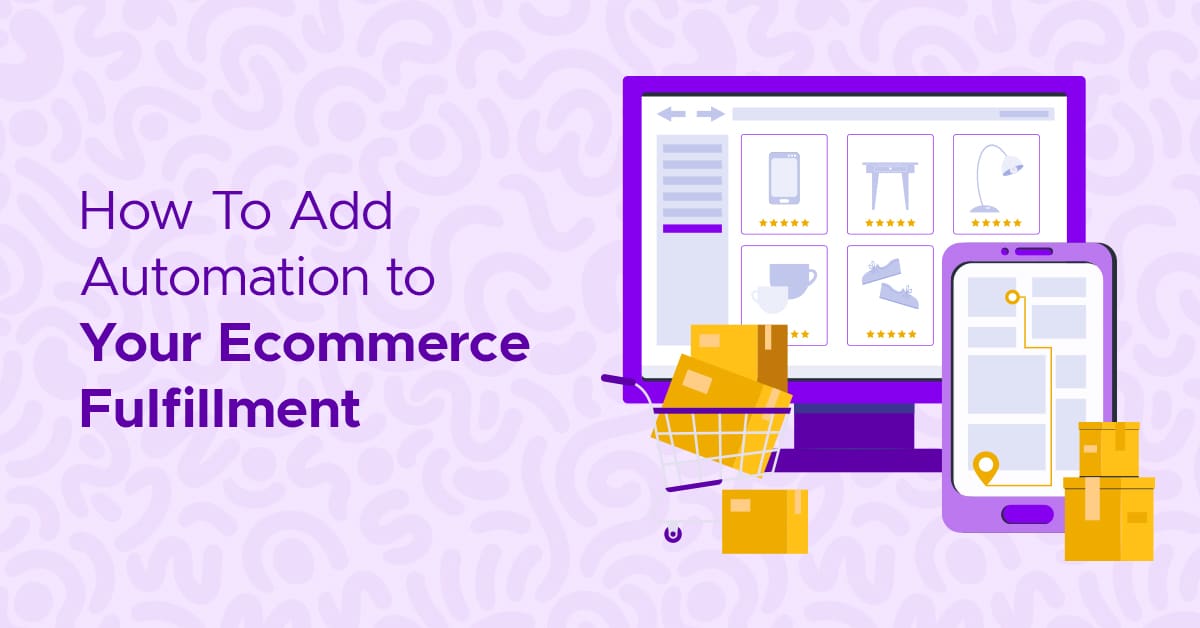
How to Add eCommerce Fulfillment Automation to Your Business

This is a guest post from Stallion Express.
Staying ahead of the competition requires eCommerce businesses to improve and optimize their logistics continuously. The fulfillment process is a crucial element that can significantly impact the efficiency, accuracy, and success of your online shopping journey. However, due to its complexity, many brands are seeking ways to offload some of the necessary tasks and so turn to eCommerce fulfillment automation to ease the burden.
This guide provides a comprehensive roadmap for brands embracing eCommerce fulfillment automation in their processes. It explores the key considerations, tools, and strategies involved in its seamless integration, empowering you to enhance the efficiency of your operations, reduce human error and fulfillment costs, and deliver an exceptional experience to your customers.
The importance of eCommerce fulfillment automation for efficiency and scalability
Imagine you run an online store and receive a growing number of orders. Manually processing each order quickly becomes time-consuming and prone to errors.
eCommerce fulfillment automation, however, leverages technology to handle routine tasks like order processing, inventory tracking, picking and packing, and shipping. By automating these processes, you can save time, minimize mistakes, and handle a larger volume of orders without overwhelming yourself or your team.
This efficiency not only improves day-to-day operations but also positions your business to grow and adapt to changes in the market more easily. eCommerce fulfillment automation thus allows you to focus on growing your brand while developing a smoother, more reliable experience for your buyers.
When introducing automation into your business, follow the below steps for an easier transition.
1. Consider your budget

Establishing a budget for automation supports realistic planning and prevents overspending on software, hardware, and training. It allows you to make strategic investments, balancing the benefits of automation with financial sustainability to foster cost-effective and efficient logistics.
When setting a budget for eCommerce fulfillment automation implementation, evaluate the costs associated with the entire process, including software, hardware, employee training, and maintenance. Prioritize essential components and explore scalable solutions. Factor in where you can save money and compare potential ROI and long-term benefits as well. As the project progresses, regularly review and adjust the budget to ensure financial alignment with your business goals.
2. Analyze your current order fulfillment process

First, you need to assess the feasibility of adopting automation tools within your budgetary limits. Conduct a comprehensive analysis of your fulfillment process by reviewing order processing, store inventory, warehouse management systems, and shipping procedures. The goal is to identify bottlenecks, measure processing times, and assess error rates. Gather feedback from employees and customers as well to uncover valuable perspectives. Utilize analytics tools and performance metrics for a detailed and data-driven evaluation.
3. Identify bottlenecks and pain points

Pinpointing bottlenecks and pain points in your eCommerce business hones in on areas causing delays or errors so you can determine which automated solutions you need. This proactive approach streamlines processes, reduces operational challenges, and facilitates smoother, more reliable eCommerce fulfillment.
To identify your brand’s bottlenecks and pain points requires a systematic methodology that includes:
- Data analysis: Review order processing, inventory levels, and shipping data to uncover delays or inconsistencies.
- Employee feedback: Gather insights from staff involved in fulfillment to understand challenges and areas of frustration.
- Customer feedback: Analyze buyer reviews and complaints for patterns related to order processing, delivery, or product availability.
- Process mapping: Create visual representations of the fulfillment process to uncover areas with slow processing or high error rates.
- Performance metrics: Track key performance indicators (KPIs) like order processing time and inventory accuracy to reveal underperforming areas.
- Technology assessment: Evaluate the efficiency of existing systems and tools, focusing on outdated or inefficient technologies.
With this approach, you can fully map your fulfillment and inventory planning, supply chain management, and logistical processes to pinpoint problems for targeted improvements.
4. Set clear objectives for implementing eCommerce fulfillment automation

Clear objectives for implementing eCommerce fulfillment automation are crucial because they provide a focused roadmap. They align technology with business goals, guide decision-making, and enable effective measurement of success. They also ensure automation addresses specific needs for a strategic, cost-effective, and successful integration into the fulfillment process.
To set clear objectives for introducing automation:
- Define your business priorities.
- Identify relevant KPIs like order processing time and error reduction.
- Set goals that are measurable, achievable, relevant, and time-bound (SMART).
- Regularly review and adjust your objectives based on evolving business needs and technological capabilities.
5. Select the right eCommerce fulfillment automation tools

The right eCommerce fulfillment automation solutions are crucial to increase productivity, reduce errors, and satisfy client demands. They enable you to automate repetitive tasks like order processing, inventory management, and shipping, which helps you scale operations, optimize resource allocation, and stay competitive.
When searching for automation tools, look at their functionality, scalability, integration capabilities, and cost-effectiveness. Conduct extensive research, seek recommendations, and test possible solutions to ensure your selections correspond with your business’s operational objectives and goals.
6. Integrate with eCommerce platforms

Integrating with eCommerce platforms facilitates real-time communication between the online storefront and fulfillment systems, which reduces manual labor and error. That cohesion boosts order accuracy, expedites order processing, and provides an efficient customer experience.
Find compatible systems and employ application programming interfaces (APIs) for effective data exchange. A robust solution should also support order processing, inventory synchronization, and shipping updates. Regularly update and test the integration to align with evolving industry and internal requirements.
7. Train employees and management

Training and managing employees throughout your eCommerce fulfillment automation is essential for successful adoption. It ensures staff proficiency in new tools, minimizes resistance to change, and promotes a collaborative work environment. In turn, that facilitates a smoother transition to maximize automation benefits and improve operational effectiveness.
Provide comprehensive training programs on new tools and technologies and foster open communication to address personnel questions and concerns. Also, implement ongoing support systems, assess employee performance regularly, and adjust training methods based on that feedback.
8. Implement automated order processing and inventory management

Modern businesses must implement automated order processing and inventory management systems to streamline operations and stay competitive. These systems reduce manual errors, expedite order fulfillment, and ensure accurate inventory tracking in real time. Businesses can optimize resource allocation, minimize costs, and enhance customer satisfaction by automating routine procedures and integrating data across platforms.
To introduce automated order processing and inventory management into your business:
- Start by integrating a robust order management system (OMS) with real-time inventory tracking capabilities into your eCommerce platform.
- Utilize software tools to automate tasks such as order confirmation, payment verification, and inventory updates. Consider customizing exception handling rules and deploying robotic process automation (RPA) to streamline manual tasks.
- Regularly review and adjust processes to ensure alignment with operational goals and enhance overall efficiency and accuracy.
9. Refine shipping and logistics

Enhancing logistics is crucial for timely and reliable deliveries. It improves order fulfillment speed, reduces shipping errors and costs, and boosts customer satisfaction. Streamlined shipping processes promote cost-effectiveness and help your business meet increasingly complex consumer expectations for faster, more efficient delivery services in the competitive eCommerce landscape.
You can improve your shipping process by partnering with reliable shipping carriers, adopting automated label generation to maintain speedy delivery times, and optimizing route planning. Also, implement real-time tracking systems for transparency and leverage data analytics to identify areas for improvement, as well as negotiate favorable shipping rates. Be sure to review and update your logistical strategies regularly to adapt to changing business needs and market conditions.
10. Monitor analytics for customer satisfaction

Customer satisfaction metrics reveal insights into purchasing patterns, preferences, and potential issues so you can understand and meet buyer expectations. As a result, you’re able to make informed decisions, improve your services, and ensure a positive consumer experience for deeper brand loyalty.
Robust monitoring and analysis require tools such as surveys, feedback forms, and net promoter scores (NPS). Additionally, track website and purchase data to identify trends and patterns and leverage social media monitoring and sentiment analysis. Regularly review customer service interactions and feedback to gauge satisfaction levels so you can make data-backed improvements accordingly.
11. Plan for scalability

Anticipating expansion in your eCommerce fulfillment automation is vital to accommodate business growth because it ensures systems and processes can handle increased order volumes. Scalability planning prevents operational bottlenecks, maintains service quality, and supports your business’s ability to adapt to market demands and capitalize on new opportunities.
Choose flexible systems and platforms and implement cloud-based solutions for easy expansion. Monitor KPIs to forecast increased demand and review and update processes to align with evolving business needs. A smooth transition to automation requires you to maintain an adaptable approach to technology and resource allocation.
Wrapping up — Automate your way to greater eCommerce success
Implementing eCommerce fulfillment automation is a strategic necessity for businesses seeking efficiency and scalability. Automated order processing, inventory and warehouse management, and shipping enhance your logistical efficiency. You can lay a strong foundation by analyzing current processes, setting clear objectives, and integrating eCommerce platforms. Train employees and address concerns as well to ease adoption.
Throughout the process, regularly monitor task efficiency through analytics to ensure customer satisfaction and plan for scalability to safeguard against future challenges. These measures create resilient and adaptive fulfillment operations that position your business for sustained success in the dynamic online landscape.
Looking to automate your logistics? Work with MyFBAPrep and make FBA prep something you never have to lose sleep over again.
